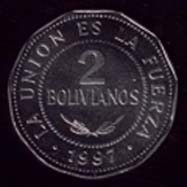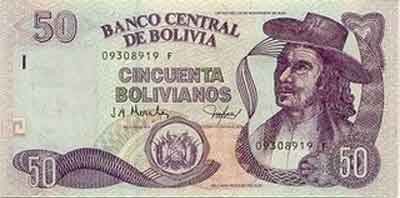|


The boliviano (ISO 4217 code: BOB) is the currency of Bolivia. It is divided into 100 centavos. Boliviano was also the name of the currency of Bolivia between 1864 and 1963.
First boliviano
The first boliviano was introduced in 1864. It was equivalent to eight soles or half a scudo in the former currency. Initially, it was subdivided into 100 cent̮̩cimos but this was altered to centavos in 1870. The name bolivar was used for an amount of ten bolivianos.
The boliviano was initially pegged at a rate of 1 boliviano = 5 French francs. On December 31, 1908, the currency was put on a new gold standard, with 12½ bolivianos = 1 British pound. A series of devaluations relative to the pound followed:
| Pegs of the boliviano to the pound |
| Date introduced |
Peg |
| July 11, 1928 |
13.5 |
| May 1932 |
17 |
| February 20, 1933 |
20 |
| April 1, 1936 |
50 |
| June 14, 1936 |
80 |
| July 29, 1937 |
120 |
| June 20, 1938 |
141 |
| September 5, 1939 |
160 |
In 1940, multiple exchange rates to the U.S. dollar were established (40 and 55 bolivianos = 1 dollar). However, the boliviano continued to fall in value. In 1963, it was replaced by the peso boliviano (ISO 4217: BOP) at a rate of one thousand to one.
Coins
In 1864, copper 1 and 2 centecimos, and silver 1/20, 1/10, 1/5 and 1 boliviano were introduced. In 1870, silver 5, 10 and 20 centavos were introduced, followed by silver 50 centavos in 1873 and copper 1 and 2 centavos in 1878. In 1883, cupro-nickel 5 and 10 centavos were introduced. Because these were similar in size to the silver 10 and 20 centavo coins, some were officially punched with a centre hole. Larger 5 and 10 centavo coins were issued from 1892. The 50 centavos was last struck in 1879, whilst the 1 and 2 centavos were last struck in 1883.
The last 5 centavos were struck in 1935, whilst, in 1937, cupro-nickel 50 centavos were introduced, followed in 1942 by issues of zinc 10 and 20 centavos and bronze 50 centavos. These were the last issues below 1 boliviano. In 1951, bronze 1, 5 and 10 bolivianos were issued.
Banknotes
In 1873, the first boliviano banknotes were issued by the Banco Nacional de Bolivia in denominations of 1, 5, 10, 20, 50 and 100 bolivianos. 20 and 40 centavo notes were added in 1875. Notes were also issued by the Banco Agricola, the Banco de Bolivia y Londres, the Banco del Comercio, the Banco Francisco Argandona, the Banco Industrial de La Paz (later the Banco Industrial), the Banco Mercatil and the Banco Potosi, with denominations of 1, 5, 10, 20, 50 and 100 bolivianos. The last issue of these private banks was made in 1911.
In 1903, the Treasury introduced notes in denominations of 50 centavos, 1, 5, 10 and 20 bolivianos. In 1911, the Banco de la NaciÃÆón Boliviana began issuing notes. The first issue, in denominations of 1, 5, 10, 20, 50 and 100 bolivianos, was overprinted on notes of the Banco de Bolivia y Londres. Regular issues, in the same denominations, followed later the same year. In 1928, the Banco Central took over paper money issuance, with notes for 1, 5, 10, 20, 50, 100, 500 and 1000 bolivianos. 5000 and 10,000 boliviano notes followed in 1942.
Second boliviano
Following many years of rampant inflation, the peso boliviano was replaced in 1987 by a new boliviano at a rate of one million to one. At that time, 1 new boliviano was roughly equivalent to 1 U.S. dollar.
Coins
In 1988, stainless-steel 2, 5, 10, 20 and 50 centavo and 1 boliviano (dated 1987) coins were introduced, followed by stainless-steel 2 bolivianos in 1991. Copper-plated steel 10 centavos were introduced in 1997 and bi-metallic 5 bolivianos in 2001. The 2 and 5 centavo coins are no longer in circulation. The 2 boliviano coin has been minted in two sizes, both of which remain legal tender. The smaller 2 boliviano coin is almost the same as the 1 boliviano coin, leading to potential confusion, although the 2 boliviano coins are undecagonal whilst the 1 boliviano coins are round.
Banknotes
In 1987, peso boliviano banknotes were overprinted with denominations in centavos and bolivianos to produce provisional issues of 1, 5, 10 and 50 centavos, and 1, 5 and 10 bolivianos. Regular issues followed the same year in denominations of 2, 5, 10, 20, 50, 100 and 200 bolivianos. The 2 boliviano note was replaced by a coin in 1991, with the same happening to the 5 boliviano in 2001, although the Bolivian central bank still lists the 5 boliviano note as "in circulation"
The text on this page has been made available under the Creative Commons Attribution-ShareAlike License and Creative Commons Licenses
|
